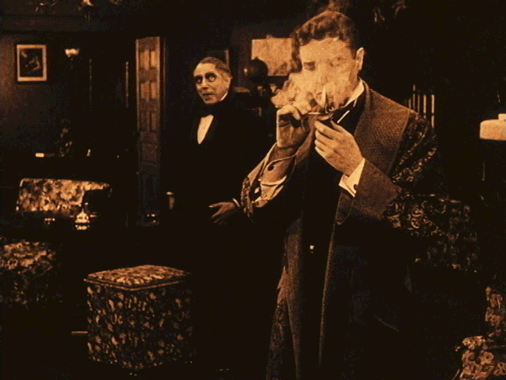

William Gillette's Sherlock Holmes
1916
"Guide du film" by Thierry Saint-Joanis

Guide du film Sherlock Holmes (1916)
with William Gillette,
written by Thierry Saint-Joanis
(president of the Société Sherlock Holmes de France, member of BSI)
in collaboration with Bernard Oudin (SSHF, BSI),
Alexis Barquin (SSHF)
& Stephen Almaseanu (SSHF).
Éditions SSHF, January 2015.
68 pages. Format A4.
Colour cover
Black & white interior
120 photos.
20 €
This silent black and white screen adaptation of the American actor’s play deserved to have a book devoted to it, not only because of its importance in the screen career of Sherlock Holmes, but because it was so long believed lost.
All the experts who have spoken so far were limited to suppositions and assumptions deduced from the testimonies of those who saw the film at the time of its release in theatres, usually recorded in the contemporary press.
When all is said and done, although the authorities on Holmesian cinema all say that this film is a milestone in the long career of the detective on the screen, they have actually been able to tell us very little about it.
Even our familiarity with the life and work of William Gillette was of little help in understanding this version of the play. When it comes to the other actors in the film, the situation is even worse. We have had to be content with their filmographies, often sparse, with very little information. The French actor Ernest Maupain is a good example. At the time of filming, he was a real movie star in the US, but now it is impossible to find more than a few lines about his life and career, and even less about his performance as Professor Moriarty in the film Sherlock Holmes.
After months of research, using the Baker Street detective’s own methods, Thierry Saint-Joanis, investigative journalist and founding president of the Sherlock Holmes Society of France, has been able to compile and review a wealth of information on this “lost film” – beyond anything we could find so far. The result of his research is now available to readers. And even if the 1916 Sherlock Holmes still keeps some secrets, we have at last brought it out of the shadows.
This detailed guide, richly illustrated with more than a hundred photos – stills taken during the shooting or frames from the film itself, and nearly all previously unpublished – is essential reading before viewing the rediscovered and restored film. And as a reference document it will help to increase and prolong the viewer’s enjoyment of these new-found and almost legendary images.
This book, which is full of information and anecdotes provides answers to many of the questions that have arisen since the demise of silent cinema in the 1930s.
The study of the film is completed with an authoritative article on William Gillette by the internationally respected Holmesian expert Bernard Oudin, author of the best-selling Enquête sur Sherlock Holmes (France, Gallimard, 2009).
Summary
-
Presentation (p. 3)
-
Data sheet (p. 9)
-
Distribution (p. 11)
-
Synopsis (p. 13)
-
Press reviews (p. 14)
-
Photos of the filmimg & film (p. 30)
-
William Gillette (p. 39)
-
W. Gillette in Strand Mag. (p. 45)
-
Ernest Maupain (p. 54)
-
William Gillette & France (p. 62)
To see the film with Flicker Alley
Long considered lost until a complete dupe negative was identified in the vaults of La Cinémathèque française in 2014, this William Gillette film is a vital missing link in the history of Sherlock Holmes on screen. By the time it was produced at Essanay Studios in 1916, Gillette had been established as the world’s foremost interpreter of Holmes on stage—having played him approximately 1300 times since his 1899 debut.
This newly-restored edition, thanks to the monumental efforts of both the San Francisco Silent Film Festival and La Cinémathèque française, represents the sole surviving appearance of Gillette’s Holmes on film.
Presented with English intertitles and an original score composed and performed by Neil Brand, Guenter Buchwald, and Frank Bockius, Flicker Alley is honored to present SHERLOCK HOLMES in streaming HD.
The film faithfully retains the play’s famous set pieces—Holmes’s encounter with Professor Moriarty, his daring escape from the Stepney Gas Chamber, and the tour-de-force deductions. It also illustrates how Gillette, who wrote the adaptation himself, wove bits from Conan Doyle’s stories ranging from “A Scandal in Bohemia” to “The Final Problem” into an original, innovative mystery play.
Film restorer Robert Byrne says, “It’s an amazing privilege to work with these reels that have been lost for generations. William Gillette’s SHERLOCK HOLMES has ranked among the holy grails of lost film and my first glimpse of the footage confirms Gillette’s magnetism. Audiences are going to be blown away when they see the original Sherlock Holmes on screen for the first time.”


























